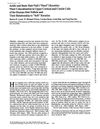TLDR Hair keratins are mainly on macrofibrils in the cortex and in the endocuticle in the cuticle.
The study utilized rapid-freezing immunocytochemistry to investigate the ultrastructural localization of hair keratins in human scalp hair shafts. This method, which involved rapid-freezing, freeze-substitution in acetone without chemical fixatives, and immunogold staining, preserved both the fine structure and antigenicity of hair keratins. The findings revealed that in the cortex, hair keratins were mainly located on the macrofibrils, while in the cuticle, they were primarily in the endocuticle, which lacked the fibrous structure of macrofibrils. This technique was deemed effective for examining the macromolecular architecture of fully keratinized human hair tissue.
61 citations
,
February 1997 in “Differentiation” 33 citations
,
October 1996 in “Journal of Investigative Dermatology” 52 citations
,
October 1995 in “Experimental Cell Research” 20 citations
,
October 1995 in “Biochimica et Biophysica Acta (BBA) - Gene Structure and Expression” 21 citations
,
January 1995 in “Molecular Biology Reports” 35 citations
,
September 1994 in “Journal of Investigative Dermatology” 47 citations
,
June 1994 in “Experimental Cell Research” 51 citations
,
March 1990 in “Journal of Investigative Dermatology” 198 citations
,
November 1989 in “The Journal of Cell Biology” The study examined the expression of keratin K14 in human skin, particularly in the epidermis and hair follicles, using monospecific antisera and cRNA probes. It was found that K14 expression and filament organization differed significantly between the hair follicle and epidermis. In the outer root sheath (ORS) cells, which are mitotically active, K14 expression was low, and keratin filaments were fewer and more loosely organized compared to basal epidermal cells. As ORS cells differentiated, they increased K14 expression and formed denser keratin bundles. In contrast, matrix cells, which can differentiate into the inner root sheath, cuticle, and hair shaft, did not express K14 or form keratin filaments. Instead, they produced hair-specific keratins and dense filament bundles without inducing K14 expression. The study suggested that the patterns of K14 expression and filament organization in skin epithelial cells were linked to their pluripotency and highlighted the distinct differentiation programs of hair follicles compared to other stratified squamous epithelia.
248 citations
,
April 1988 in “Differentiation”  356 citations
,
December 1986 in “The journal of cell biology/The Journal of cell biology”
356 citations
,
December 1986 in “The journal of cell biology/The Journal of cell biology” Hair and nail cells share similar proteins, indicating a common differentiation pathway.
81 citations
,
May 1986 in “Journal of Investigative Dermatology”
